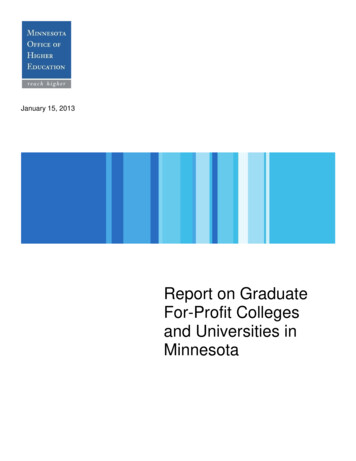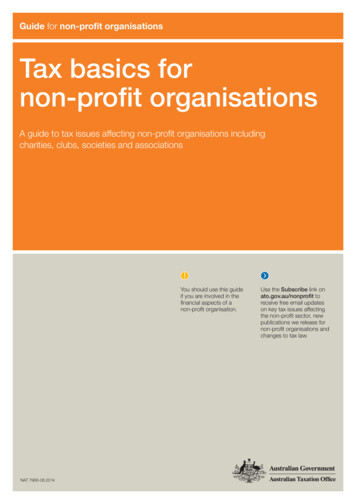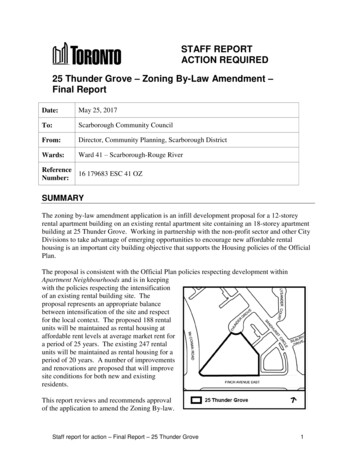
Transcription
January 15, 2013Report on GraduateFor-Profit Collegesand Universities inMinnesota
AuthorsAbout the Minnesota Office of Higher EducationJohn ArmstrongThe Minnesota Office of Higher Education is a cabinet-level stateagency providing students with financial aid programs and informationto help them gain access to postsecondary education. The agencyalso serves as the state’s clearinghouse for data, research andanalysis on postsecondary enrollment, financial aid, finance andtrends.Data Analyst InternTel: 651-259-3977john.armstrong@state.mn.usGeorge RoedlerManager, Institutional Registration andLicensingTel: 651-259-3975george.roedler@state.mn.usThe Minnesota State Grant Program is the largest financial aidprogram administered by the Office of Higher Education, awarding upto 150 million in need-based grants to Minnesota residents attendingeligible colleges, universities and career schools in Minnesota. Theagency oversees other state scholarship programs, tuition reciprocityprograms, a student loan program, Minnesota’s 529 College SavingsPlan, licensing and early college awareness programs for youth.In addition, the Minnesota Office of Higher Education licenses andregisters private and out-of-state public colleges and universities andcareer schools as a part of its consumer protection mission.
Table of ContentsIntroduction .3Method of Collecting Information .3Findings .4Intellectual Property.4Graduate Student Disciplinary Processes.6Academic Freedom of Inquiry for Students .6Administrative Processes to Solve Disputes .7Recommendations.7Appendix A: Letter to For-Profits.8Appendix B: Letter to Not-For-Profits .9Minnesota Office of Higher Education1
2Minnesota Office of Higher Education
IntroductionThe Office of Higher Education (OHE) was directed by the Minnesota State Legislature to report ongraduate for-profit colleges and universities regarding graduate student rights and responsibilities*. Thefollowing four topics were examined at Minnesota's graduate for-profit institutions:A.B.C.D.Graduate Students Intellectual Property RightsGraduate Student Disciplinary ProcessesGuidelines Addressing Academic Freedom of Inquiry for StudentsAdministrative Processes in Place to Address DisputesMethod of Collecting InformationOHE sent letters requesting copies of institutional policies relating to the four topics of the study tograduate for-profit colleges and universities in the state, including national for-profit corporationsheadquartered outside of Minnesota with a physical campus in Minnesota. All institutions were willingto provide their documentation and OHE thanks them for their prompt responses. For-profit institutionsthat offer graduate degrees with a campus in Minnesota include: American Academy of Acupuncture and Oriental Medicine (Local, one campus)Argosy University (National, headquartered out of state)Capella University (National, headquartered in MN)DeVry University (National, headquartered out of state)Globe University (Regional, operates in some neighboring states, headquartered in MN)Herzing University (National, headquartered out of state)McNally Smith College of Music (Local, one campus)National American University (National, headquartered out of state)University of Phoenix (National, headquartered out of state)Vesper College (Local, one campus)Walden University (National, headquartered in MN)For comparison, OHE requested the same information from MnSCU, the University of Minnesota and afew private not-for-profit institutions. OHE selected not-for-profit institutions on the basis of their sizeand their ability to represent trends in the non-profit sector. This information was solicited to determineif policies at for-profits were different from those in the other sectors based on clarity,comprehensiveness or if the institution has enacted policies in regards to academic freedom andintellectual property. Submitting this information was not required of non-profit institution and OHEthanks them for their willingness to contribute to this report. The private not-for-profit institutionsinclude: Augsburg CollegeBethel UniversityConcordia CollegeNorthwestern CollegeSaint Catherine's UniversitySaint Marys University of MinnesotaUniversity of Saint Thomas* This request initially stemmed from a complaint brought to the attention of the legislature by a former graduate student who claimed thatintellectual property was misappropriated by an institution and /or a professor.Minnesota Office of Higher Education3
OHE reviewed the documentation provided by these institutions to look for substantive differencesamong institutions and to determine which policies were clear and comprehensive and thus, easilyunderstood by students, faculty and other interested parties.Copies of the letters sent to both for-profit and not-for-profit institutions are located in Appendix A andAppendix B.General FindingsOverall, OHE observed a great deal of variation among responses from institutions in both for-profit andnot-for-profit /public sectors in the areas pertaining to intellectual property and academic freedom ofinquiry. Institutional policies regarding graduate student disciplinary processes and policies in place toaddress disputes were more uniform and comprehensive. In general, the for-profit sector as a whole haswritten policies that are similar to other sectors. Specifically, compared to the public and not-for profitsectors, the for-profit sector in Minnesota is neither unique nor deficient in regard to these policies.A) Intellectual PropertyInstitutions in the for-profit, not-for-profit and public sectors fell into one of three classifications inregards to their intellectual property policies. The classifications are:1. The intellectual property policy clearly states that works created by students and/or facultybelong to the creator of that work.2. The intellectual property policy clearly states that works created by students and/or facultybelong to the institution.3. The institution lacks a comprehensive intellectual property policy.The distribution among the three classifications is incredibly similar among public, not-for-profit, andfor-profit institutions. Nearly 50% of institutions in the public, not-for-profit and for-profit sectors fellinto the third classification, lacking a comprehensive intellectual property policy. The remaininginstitutions in the three sectors mostly had policies clearly stating that works created are the property ofthe individual who created that work. Only two institutions across all sectors had policies clearly statingany works created are the property of the institution. The impetus for the institution owning the work ofthe student or faculty member was not related to the institution’s sector.4Minnesota Office of Higher Education
50%Intellectual Property Policies at MN Institutions45% 44%45%45% 44%40%For-Profit Institutions35%30%Public and dent / Faculty Institution OwnsOwn RightsRightsNoComprehensivePolicySource: Office of Higher Education Study of Selected Institutions*Data may not add to 100% due to roundingIntellectual Property is a complicated subject matter. Some institutions have separate policies for theirstudents and their faculty. Others explained that students may pursue copyright protections for theirwork and still others denoted a list of exceptions to their rules. Some institutions with no comprehensivepolicy regarding intellectual property have vague statements that could be misinterpreted by students,faculty, and outside observers.To be effective, these policies need to clearly articulate institutional positions on intellectual property torelevant participants. Language that is clear, easily understood, and effectively conveys where a studentor faculty member stands in regards to any work they create is needed at all institutions, for-profit, notfor-profit and public. There are a few examples of policy that meet the criteria of being clear and easilyunderstood. Here are examples of such policies:“The [Name of Institution] student who creates intellectual property owns the intellectual property”“In accordance with the law of copyright, faculty-assigned student writings, including answer material fortests, projects, research papers and business plans prepared in connection with any course, are theproperty of [Name of Institution] and may be used by the School for educational purposes.”Finding:Intellectual Property policies are most effective if they are located in an easily accessible place forstudents and faculty to access, such as in the student catalog or faculty handbook. Many institutionssurveyed do not have easily accessed policies and still others have no policy whatsoever. Institutionsthat lack clearly defined statements may find themselves at risk of entering a legal dispute regardingintellectual property.Minnesota Office of Higher Education5
B) Graduate Student Disciplinary ProcessesAll institutions surveyed for this report provided descriptions of their disciplinary processes. Theymentioned under what conditions a student shall be subject to disciplinary action. Examples of suchdisciplinary action include:-Verbal Warning-Written Warning-Academic Probation-Suspension-DismissalWhile there is variation among institutions regarding the severity of certain graduate studenttransgressions, these policies are clear, easily understood, and located in an easily accessible documentfor students to access.Finding:Under the current Minnesota Private and Out-of-State Public Postsecondary Education Act (MnStat136A.61-136A.71) institutions are required to publish their disciplinary process and procedures. Allinstitutions surveyed are in compliance with this section of the statute.C) Academic Freedom of Inquiry for StudentsAcademic Freedom is a central tenet of higher education in the United States. It refers to the right ofstudents and faculty to express opinions without fear of disciplinary action or retribution from theirinstitutions. The American Association of University Professors states:“Students and student organizations should be free to examine and discuss all questions of interest tothem and to express opinions publicly and privately. They should always be free to support causes byorderly means that do not disrupt the regular and essential operations of the institution. At the same time,it should be made clear to the academic and larger community that in their public expressions ordemonstrations students or student organizations speak only for themselves.”Many schools in this study provided statements that broadly express their commitment to academicfreedom for their students. Here are a few examples:“[Name of Institution] supports the development of autonomous thought and respect for the ideas ofothers”“It is [Name of Institution] policy to safeguard the free exchange of ideas and to not limit the legal rightsof any members of the community”Some institutions had clear policies on academic freedom for faculty, but less specific or clear policieson academic freedom for students. These institutions did not have a policy specifically dedicated to theconcept of academic freedom of inquiry but have statements regarding freedom of expression in othersections of their catalog or student handbook. These statements were embedded within other broaderpolicies relating to education goals, instructional policies, and other institutional policies or goals.6Minnesota Office of Higher Education
Finding:Minnesota Statute Chapter 136A.65 sub.4 (6) requires that each school have a policy on freedom orlimitation of expression and inquiry for faculty and students. OHE recommends that institutions who donot have a policy on academic freedom revise their documents to specifically address academic freedomfor both their students and faculty.D) Administrative Processes to Solve DisputesA typical institution explains that disputes not resolved between the student and relevant parties aretaken to either a dean, other administrator, or are subject to committee review. If these processes fail,the student may elect binding arbitration or further their complaints to the university’s accreditor, OHE,or seek legal redress for their claims.Finding:The documentation provided to OHE addressing dispute resolution is largely comprehensive and easilyunderstood and accessible. Minnesota Statute Chapter 141.25 sub.9 (15) requires licensed institutions tolist the address of OHE in their catalog so that students are aware that they can take their complaints toOHE. It is recommended that the legislature consider adding this requirement to the Minnesota Privateand Out-of-State Postsecondary Education Act.RecommendationsRecommendations resulting from this report are intended for all institutions that offer graduateeducation in Minnesota including public, not-for-profit and for-profit institutions.A large number of institutions lack policies regarding A) intellectual property and C) academic freedomof inquiry. OHE sees the potential for these institutions to be subject to legal action similar to thesituation legislators observed that prompted the request for this report. OHE recommends the legislatureconsider the following action:Amending the Minnesota Private and Out-of State Public Postsecondary Education Act (MnStat136A.65 sub.4(6) to include the following:1. Requiring a clear, easily understood, and accessible policy with regards to intellectualproperty created by a student or faculty member. (Topic A)2. Requiring that a policy specifically addressing academic freedom for students bewritten in each institution’s catalog, brochure, or electronic display. (Topic C)3. Requiring that institutions registered with OHE clearly publicize OHE’s name,address and website in their catalog, brochure, or electronic display as a resource foraddressing student complaints. (Topic D)Minnesota Office of Higher Education7
Appendix A: Letter to For-Profits8Minnesota Office of Higher Education
Appendix B: Letter to Not-For-ProfitsMinnesota Office of Higher Education9
agency oversees other state scholarship programs, tuition reciprocity programs, a student loan program, Minnesota's 529 College Savings . McNally Smith College of Music (Local, one campus) National American University (National, headquartered out of state)











